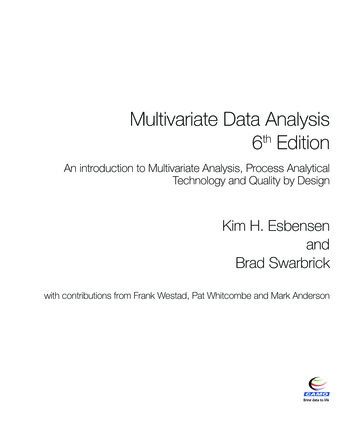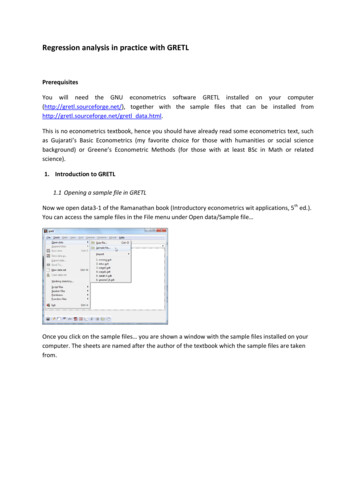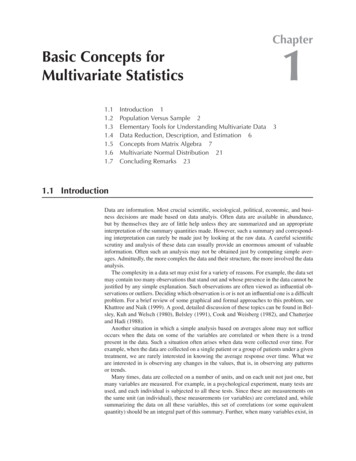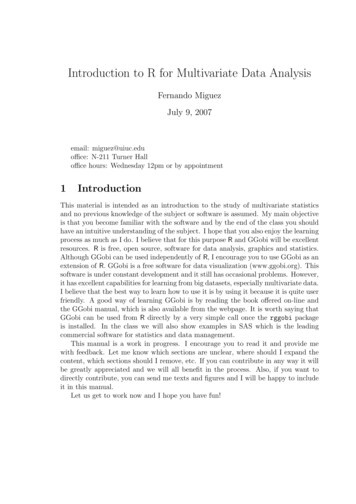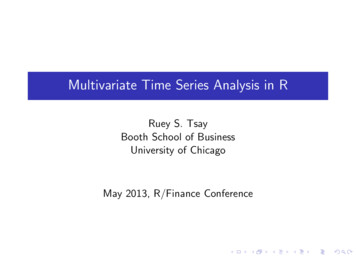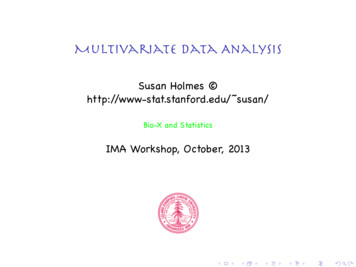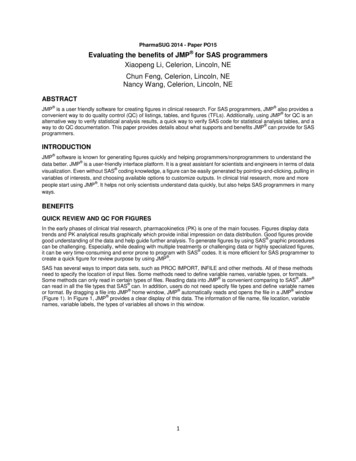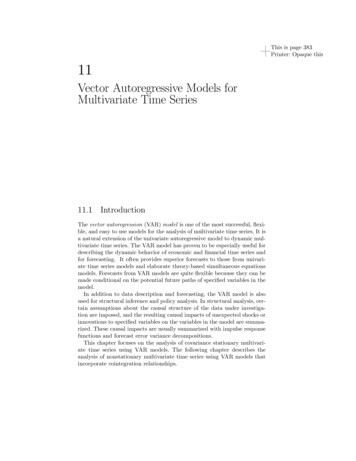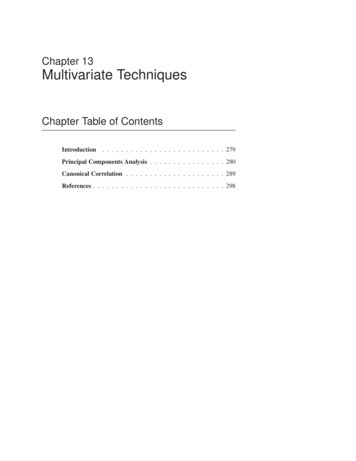
Transcription
Continue
Applied multivariate statistical analysis 6e solution manual pdfInstructor's Solutions Manual (Download only) for Applied Multivariate Statistical Analysis, 6/ERichard Johnson, University of Wisconsin-MadisonDean W. Wichern, Texas A&M University, College Station productFormatCode W22 productCategory 12 statusCode 5 isBuyable false subType path/ProductBean/courseSmart ISBN-10: 0132326809 ISBN-13: 978013232680397801323268039780132326803 2008 Pearson Online Published 03/15/2007 Live prodCategory : 12 statusCode : 5About ThisProductDownloadResourcesPackagesAbout This Product Preface (PDF) Courses Pearson Higher Education offers special pricing when you choose to package your text with other studentresources. If you're interested in creating a cost-saving package for your students contact your Pearson Higher Education representative. Home » Shop » Solution Manual For Applied Multivariate Statistical Analysis You've just added this product to the cart: APPLIED MULTIVARIATE SIXTH EDITION STAT STICAL ANALYS S R I CHARD A . , . . DE A N JOHNSON · · W. WICHERN Applied Multivariate Statistical Analysis SIXTH EDITION Applied Multivariate Statistical Analysis RICHARD A. JOHNSON University of Wisconsin-Madison DEAN W. WICHERN Texas A&M University Upper Saddle River, New Jersey 07458 .brary of Congress Cataloging-in- Publication Data mnson, Richard A.Statistical analysis/Richard A. Johnson.-6'" ed. Dean W. Winchern p.cm. Includes index. ISBN 0.13-187715-1 1. Statistical Analysis '":IP Data Available \xecutive Acquisitions Editor: Petra Recter Vice President and Editorial Director, Mathematics: Christine Haag roject Manager: Michael Bell Production Editor: Debbie Ryan . enior Managing Editor:Lindd Mihatov Behrens anufacturing Buyer: Maura Zaldivar Associate Director of Operations: Alexis Heydt-Long Aarketing Manager: Wayne Parkins darketing Assistant: Jennifer de Leeuwerk &Iitorial Assistant/Print Supplements Editor: Joanne Wendelken \rt Director: Jayne Conte Director of Creative Service: Paul Belfanti .::Over Designer: BruceKenselaar 1\rt Studio: Laserswords 2007 Pearson Education, Inc. Pearson Prentice Hall Pearson Education, Inc. Upper Saddle River, NJ 07458 All rights reserved. No part of this book may be reproduced, in any form or by any means, without permission in writing from the publisher. Pearson Prentice HaHn is a tradeq ark of Pearson Education,Inc. Printed in the United States of America 10 9 8 7 6 5 4 3 2 1 ISBN-13: 978-0-13-187715-3 ISBN-10: 0-13-187715-1 Pearson Education LID., London Pearson Education Australia P'IY, Limited, Sydney Pearson Education Singapore, Pte. Ltd Pearson Education North Asia Ltd, Hong Kong Pearson Education Canada, Ltd., Toronto Pearson Educaci6nde Mexico, S.A. de C.V. Pearson Education-Japan, Tokyo Pearson Education Malaysia, Pte. Ltd To the memory of my mother and my father. R.A.J. To Doroth Michael, and Andrew. D.WW Contents PREFACE 1 XV 1 ASPECTS OF MULTIVARIATE ANALYSIS 1.1 1.2 1.3 Introduction 1 Applications of Multivariate Techniques The Organization of Data 5 3Arrays,5 Descriptive Statistics, 6 Graphical Techniques, 1J 1.4 Data Displays and Pictorial Representations 19 Linking Multiple Two-Dimensional Scatter Plots, 20 Graphs of Growth Curves, 24 Stars, 26 Chernoff Faces, 27 1.5 1.6 2 Distance 30 Final Comments 37 Exercises 37 References 47 49 MATRIX ALGEBRA AND RANDOM VECTORS 2.1 2.2Introduction 49 Some Basics of Matrix and Vector Algebra 49 Vectors, 49 Matrices, 54 2.3 2.4 2.5 2.6 Positive Definite Matrices 60 A Square-Root Matrix 65 Random Vectors and Matrices 66 Mean Vectors and Covariance Matrices 68 Partitioning the Covariance Matrix, 73 The Mean Vector and Covariance Matrix for Linear Combinations of RandomVariables, 75 Partitioning the Sample Mean Vector and Covariance Matrix, 77 2.7 Matrix Inequalities and Maximization 78 vii viii Contents Supplement 2A: Vectors and Matrices: Basic Concepts 82 Vectors, 82 Matrices, 87 Exercises 103 References 110 3 SAMPLE GEOMETRY AND RANDOM SAMPLING 3.1 3.2 3.3 3.4 111 Introduction 111 TheGeometry of the Sample 111 Random Samples and the Expected Values of the Sample Mean and Covariance Matrix 119 Generalized Variance 123 Situo.tions in which the Generalized Sample Variance Is Zero, I29 Generalized Variance Determined by I R I and Its Geometrical Interpretation, 134 Another Generalization of Variance, 137 3.5 3.6 4Sample Mean, Covariance, and Correlation As Matrix Operations 137 Sample Values of Linear Combinations of Variables Exercises 144 References 148 140 THE MULTIVARIATE NORMAL DISTRIBUTION 4.1 4.2 Introduction 149 The Multivariate Normal Density and Its Properties 149 149 Additional Properties of the Multivariate NormalDistribution, I 56 4.3 Sampling from a Multivariate Normal Distribution and Maximum Likelihood Estimation 168 The Multivariate Normal Likelihood, I68 Maximum Likelihood Estimation of 1.t and 1:, I70 Sufficient Statistics, I73 4.4 The Sampling Distribution of X and S 173 Propenies of the Wishart Distribution, I74 4.5 4.6 Large-Sample Behavior ofX and S 175 Assessing the Assumption of Normality 177 Evaluating the Normality of the Univariate Marginal Distributions, I77 Evaluating Bivariate Normality, I82 4.7 Detecting Outliers and Cleaning Data 187 Steps for Detecting Outliers, I89 4.8 'fiansfonnations to Near Normality 192 Transforming Multivariate Observations, I95 Exercises 200References 208 Contents 5 210 INFERENCES ABOUT A MEAN VECTOR 5.1 5.2 5.3 ix Introduction 210 The Plausibility of p. 0 as a Value for a Normal Population Mean 210 Hotelling's T 2 and Likelihood Ratio Tests 216 General Likelihood Ratio Method, 219 5.4 Confidence Regions and Simultaneous Comparisons of Component Means 220Simultaneous Confidence Statements, 223 A Comparison of Simultaneous Confidence Intervals with One-at-a-Time Intervals, 229 The Bonferroni Method of Multiple Comparisons, 232 5.5 5.6 Large Sample Inferences about a Population Mean Vector Multivariate Quality Control Charts 239 234 Charts for Monitoring a Sample of IndividualMultivariate Observations for Stability, 241 Control Regions for Future Individual Observations, 247 Control Ellipse for Future Observations, 248 T 2 -Chart for Future Observations, 248 Control Chans Based on Subsample Means, 249 Control Regions for Future Subsample Observations, 251 5.7 5.8 6 Inferences about Mean Vectors when SomeObservations Are Missing 251 Difficulties Due to Time Dependence in Multivariate Observations 256 Supplement SA: Simultaneous Confidence Intervals and Ellipses as Shadows of the p-Dimensional Ellipsoids 258 Exercises 261 References 272 273 COMPARISONS OF SEVERAL MULTIVARIATE MEANS 6.1 6.2 Introduction 273 Paired Comparisonsand a Repeated Measures Design 273 Paired Comparisons, 273 A Repeated Measures Design for Comparing ]}eatments, 279 6.3 Comparing Mean Vectors from Two Populations 284 Assumptions Concerning the Structure of the Data, 284 Funher Assumptions When n 1 and n 2 Are Small, 285 Simultaneous Confidence Intervals, 288 The Two-SampleSituation When 1:1 !.2, 291 An Approximation to the Distribution of T 2 for Normal Populations When Sample Sizes Are Not Large, 294 * 6.4 Comparing Several Multivariate Population Means (One-Way Manova) 296 Assumptions about the Structure of the Data for One-Way MAN OVA, 296 Contents A Summary of Univariate ANOVA, 297 MultivariateAnalysis ofVariance (MANOVA), 30I 6.5 6.6 6.7 Simultaneous Confidence Intervals for Treatment Effects 308 Testing for Equality of Covariance Matrices 310 1\vo-Way Multivariate Analysis of Variance 312 Univariate Two-Way Fixed-Effects Model with Interaction, 312 Multivariate 1Wo-Way Fixed-Effects Model with Interaction, 3I5 6.8 6.9 6.10 7Profile Analysis 323 Repeated Measures Designs and Growth Curves 328 Perspectives and a Strategy for Analyzing Multivariate Models 332 Exercises 337 References 358 MULTIVARIATE LINEAR REGRESSION MODELS 7.1 7.2 7.3 360 Introduction 360 The Classical Linear Regression Model 360 Least Squares Estimation 364 Sum-of-SquaresDecomposition, 366 Geometry of Least Squares, 367 Sampling Properties of Classical Least Squares Estimators, 369 7.4 Inferences About the Regression Model 370 Inferences Concerning the Regression Parameters, 370 Likelihood Ratio Tests for the Regression Parameters, 374 7.5 Inferences from the Estimated Regression Function 378 Estimatingthe Regression Function atz 0 , 378 Forecasting a New Observation at z0 , 379 7.6 Model Checking and Other Aspects of Regression 381 Does the Model Fit?, 38I Leverage and Influence, 384 Additional Problems in Linear Regression, 384 7.7 Multivariate Multiple Regression 387 Likelihood Ratio Tests for Regression Parameters, 395 OtherMultivariate Test Statistics, 398 Predictions from Multivariate Multiple Regressions, 399 7.8 The Concept of Linear Regression 401 Prediction of Several Variables, 406 Partial Correlation Coefficient, 409 7.9 Comparing the 1\vo Formulations of the Regression Model 410 Mean Corrected Form of the Regression Model, 4IO Relating the Formulations,412 7.10 Multiple Regression Models with Time Dependent Errors 413 Supplement 7A: The Distribution of the Likelihood Ratio for the Multivariate Multiple Regression Model Exercises- 420 References 428 418 Contents 8 430 PRINCIPAL COMPONENTS 8.1 8.2 xi Introduction 430 Population Principal Components 430 Principal ComponentsObtained from Standardized Variables, 436 Principal Components for Covariance Matrices with Special Structures, 439 8.3 Summarizing Sample Variation by Principal Components 441 The Number of Principal Components, 444 Interpretation of the Sample Principal Components, 448 Standardizing the Sample Principal Components, 449 8.4 8.5 8.6Graphing the Principal Components 454 Large Sample Inferences 456 Large Sample Propenies of A; and e;, 456 Testing for the Equal Correlation Structure, 457 Monitoring Quality with Principal Components 459 Checking a Given Set of Measurements for Stability, 459 Controlling Future Values, 463 Supplement 8A: The Geometry of the SamplePrincipal Component Approximation 466 The p-Dimensional Geometrical Interpretation, 468 Then-Dimensional Geometrical Interpretation, 469 Exercises 470 References 480 9 FACTOR ANALYSIS AND INFERENCE FOR STRUCTURED COVARIANCE MATRICES 9.1 9.2 9.3 Introduction 481 The Orthogonal Factor Model Methods of Estimation 488481 482 The Principal Component (and Principal Factor) Method, 488 A Modified Approach-the Principal Factor Solution, 494 The Maximum Likelihood Method, 495 A Large Sample Test for the Number of Common Factors, 501 9.4 Factor Rotation 504 Oblique Rotations, 512 9.5 Factor Scores 513 The Weighted Least Squares Method, 514 TheRegression Method, 516 9.6 Perspectives and a Strategy for Factor Analysis 519 Supplement 9A: Some Computational Details for Maximum Likelihood Estimation Recommended Computational Scheme, 528 Maximum Likelihood Estimators of p L,L 1/1, Exercises 530 References 538 529 52 7 xii Contents 10 CANONICAL CORRELATIONANALYSIS 10.1 10.2 10.3 539 Introduction 539 Canonical Variates and Canonical Correlations 539 Interpreting the Population Canonical Variables 545 Identifying the {:anonical Variables, 545 Canonical Correlations as Generalizations of Other Correlation Coefficients, 547 The First r Canonical Variables as a Summary of Variability, 548 AGeometrical Interpretation of the Population Canonical Correlation Analysis 549 10.4 10.5 The Sample Canonical Variates and Sample Canonical Correlations 550 Additional Sample Descriptive Measures 558 Matrices of Errors of Approximations, 558 Proportions of Explained Sample Variance, 561 10.6 11 Large Sample Inferences 563 Exercises 567References 574 DISCRIMINAnON AND CLASSIFICATION 11.1 11.2 11.3 11.4 11.5 Introduction 575 Separation and Classification for 1\vo Populations 576 Classification with 1\vo Multivariate Normal Populations Classification of Normal Populations When It I 2 I, 584 Scaling, 589 Fisher's Approach to Classification with 1Wo Populations, 590 IsClassification a Good Idea?, 592 Classification of Normal Populations When It #' I 2 , 593 Evaluating Classification Functions 596 Classification with Several Populations 606 The Minimum Expected Cost of Misclassl:fication Method, 606 Qassification with Normal Populations, 609 11.6 Fisher's Method for Discriminating among Several Populations621 11.7 Logistic Regression and Classification 634 Using Fisher's Discriminants to Classify Objects, 628 Introduction, 634 The Logit Model, 634 Logistic Regression Analysis, 636 Classiftcation, 638 Logistic Regression With Binomial Responses, 640 11.8 Final Comments 644 Including Qualitative Variables, 644 Classification ]}ees, 644 NeuralNetworks, 647 Selection of Variables, 648 575 584 Contents xiii Testing for Group Differences, 648 Graphics, 649 Practical Considerations Regarding Multivariate Normality, 649 Exercises 650 References 669 12 CLUSTERING, DISTANCE METHODS, AND ORDINATION 12.1 12.2 Introduction 671 Similarity Measures 671 673 Distances andSimilarity Coefficients for Pairs of Items, 673 Similarities and Association Measures for Pairs of Variables, 677 Concluding Comments on Similarity, 678 12.3 Hierarchical Clustering Methods 680 Single Linkage, 682 Complete Linkage, 685 Average Linkage, 690 Wards Hierarchical Clustering Method, 692 Final Comments-Hierarchical Procedures,695 12.4 Nonhierarchical Clustering Methods 696 K-means Method, 696 Final Comments-Nonhierarchlcal Procedures, 701 12.5 12.6 Clustering Based on Statistical Models Multidimensional Scaling 706 12.7 Correspondence Analysis 716 The Basic Algorithm, 708 703 . Algebraic Development of Correspondence Analysis, 718 Inertia, 725Interpretation in Two Dimensions, 726 Final Comments, 726 12.8 Biplots for Viewing Sampling Units and Variables 726 12.9 Procrustes Analysis: A Method for Comparing Configurations 732 Constructing Biplots, 727 Constructing the Procrustes Measure ofAgreement, 733 Supplement 12A: Data Mining 740 Introduction, 740 The Data MiningProcess, 741 Model Assessment, 742 Exercises 747 References 755 APPENDIX 757 DATA INDEX 764 SUBJECT INDEX 767 Preface INTENDED AUDIENCE This book originally grew out of our lecture notes for an "Applied Multivariate Analysis" course offered jointly by the Statistics Department and the School of Business at the University ofWisconsin-Madison. Applied Multivariate Statistica/Analysis, Sixth Edition, is concerned with statistical methods for describing and analyzing multivariate data. Data analysis, while interesting with one variable, becomes truly fascinating and challenging when several variables are involved. Researchers in the biological, physical, and social sciencesfrequently collect measurements on several variables. Modern computer packages readily provide the· numerical results to rather complex statistical analyses. We have tried to provide readers with the supporting knowledge necessary for making proper interpretations, selecting appropriate techniques, and understanding their strengths andweaknesses. We hope our discussions will meet the needs of experimental scientists, in a wide variety of subject matter areas, as a readable introduction to the statistical analysis of multivariate observations. LEVEL Our aim is to present the concepts and methods of multivariate analysis at a level that is readily understandable by readers who havetaken two or more statistics courses. We emphasize the applications of multivariate methods and, consequently, have attempted to make the mathematics as palatable as possible. We avoid the use of calculus. On the other hand, the concepts of a matrix and of matrix manipulations are important. We do not assume the reader is familiar with matrixalgebra. Rather, we introduce matrices as they appear naturally in our discussions, and we then show how they simplify the presentation of multivariate models and techniques. The introductory account of matrix algebra, in Chapter 2, highlights the more important matrix algebra results as they apply to multivariate analysis. The Chapter 2supplement provides a summary of matrix algebra results for those with little or no previous exposure to the subject. This supplementary material helps make the book self-contained and is used to complete proofs. The proofs may be ignored on the first reading. In this way we hope to make the book accessible to a wide audience. In our attempt tomake the study of multivariate analysis appealing to a large audience of both practitioners and theoreticians, we have had to sacrifice XV xvi Preface a consistency of level. Some sections are harder than others. In particular, we have summarized a voluminous amount of material on regression in Chapter 7. The resulting presentation is rather succinctand difficult the first time through. we hope instructors will be able to compensate for the unevenness in level by judiciously choosing those sections, and subsections, appropriate for their students and by toning them tlown if necessary. ORGANIZATION AND APPROACH The methodological "tools" of multivariate analysis are contained in Chapters 5through 12. These chapters represent the heart of the book, but they cannot be assimilated without much of the material in the introductory Chapters 1 through 4. Even those readers with a good knowledge of matrix algebra or those willing to accept the mathematical results on faith should, at the very least, peruse Chapter 3, "Sample Geometry,"and Chapter 4,"Multivariate Normal Distribution." Our approach in the methodological chapters is to keep the discussion direct and uncluttered. Typically, we start with a formulation of the population models, delineate the corresponding sample results, and liberally illustrate everything with examples. The examples are of two types: those that aresimple and whose calculations can be easily done by hand, and those that rely on real-world data and computer software. These will provide an opportunity to (1) duplicate our analyses, (2) carry out the analyses dictated by exercises, or (3) analyze the data using methods other than the ones we have used or suggested . .The division of themethodological chapters (5 through 12) into three units allows instructors some flexibility in tailoring a course to their needs. Possible sequences for a one-semester (two quarter) course are indicated schematically. Each instructor will undoubtedly omit certain sections from some chapters to cover a broader collection of topics than is indicated bythese two choices. Getting Started Chapters 1-4 For most students, we would suggest a quick pass through the first four chapters (concentrating primarily on the material in Chapter 1; Sections 2.1, 2.2, 2.3, 2.5, 2.6, and 3.6; and the "assessing normality" material in Chapter 4) followed by a selection of methodological topics. For example, one mightdiscuss the comparison of mean vectors, principal components, factor analysis, discriminant analysis and clustering. The discussions could feature the many "worked out" examples included in these sections of the text. Instructors may rely on di- Preface xvii agrams and verbal descriptions to teach the corresponding theoretical developments. If thestudents have uniformly strong mathematical backgrounds, much of the book can successfully be covered in one term. We have found individual data-analysis projects useful for integrating material from several of the methods chapters. Here, our rather complete treatments of multivariate analysis of variance (MANOVA), regression analysis, factoranalysis, canonical correlation, discriminant analysis, and so forth are helpful, even though they may not be specifically covered in lectures. CHANGES TO THE SIXTH EDITION New material. Users of the previous editions will notice several major changes in the sixth edition. Twelve new data sets including national track records for men andwomen, psychological profile scores, car body assembly measurements, cell phone tower breakdowns, pulp and paper properties measurements, Mali family farm data, stock price rates of return, and Concho water snake data. Thirty seven new exercises and twenty revised exercises with many of these exercises based on the new data sets. Fournew data based examples and fifteen revised examples. Six new or expanded sections: 1. Section 6.6 Testing for Equality of Covariance Matrices 2. Section 11.7 Logistic Regression and Classification 3. Section 12.5 Clustering Based on Statistical Models 4. Expanded Section 6.3 to include "An Approximation to th Distribution of T 2 for NormalPopulations When Sample Sizes are not Large" 5. Expanded Sections 7.6 and 7.7 to include Akaike's Information Criterion 6. Consolidated previous Sections 11.3 and 11.5 on two group discriminant analysis into single Section 11.3 Web Site. To make the methods of multivariate analysis more prominent in the text, we have removed the long proofs ofResults 7.2, 7.4, 7.10 and 10.1 and placed them on a web site accessible through www.prenhall.com/statistics. Click on "Multivariate Statistics" and then click on our book. In addition, all full data sets saved as ASCII files that are used in the book are available on the web site. Instructors' Solutions Manual. An Instructors Solutions Manual is availableon the author's website accessible through www.prenhall.com/statistics. For information on additional for-sale supplements that may be used with the book or additional titles of interest, please visit the Prentice Hall web site at www.prenhall.com. ""iii Preface ,ACKNOWLEDGMENTS We thank many of our colleagues who helped improve the appliedaspect of the book by contributing their own data sets for examples and exercises. A number of individuals helped guide various revisions of this book, and we are grateful for their suggestions: Christopher Bingham, University of Minnesota; Steve Coad, University of Michigan; Richard Kiltie, University of Florida; Sam Kotz, George Mason University;Him Koul, Michigan State University; Bruce McCullough, Drexel University; Shyamal Peddada, University of Virginia; K. Sivakumar University of Illinois at Chicago; Eric mith, Virginia Tech; and Stanley Wasserman, University of Illinois at Urbana-Champaign. We also acknowledge the feedback of the students we have taught these past 35 years inour applied multivariate analysis courses. Their comments and suggestions are largely responsible for the present iteration of this work. We would also like to give special thanks to Wai Kwong Cheang, Shanhong Guan, Jialiang Li and Zhiguo Xiao for their help with the calculations for many of the examples. We must thank Dianne Hall for her valuablehelp with the Solutions Manual, Steve Verrill for computing assistance throughout, and Alison Pollack for implementing a Chernoff faces program. We are indebted to Cliff Gilman for his assistance with the multidimensional scaling examples discussed in Chapter 12. Jacquelyn Forer did most of the typing of the original draft manuscript, and weappreciate her expertise and willingness to endure cajoling of authors faced with publication deadlines. Finally, we would like to thank Petra Recter, Debbie Ryan, Michael Bell, Linda Behrens, Joanne Wendelken and the rest of the Prentice Hall staff for their help with this project. R. A. Johnson [email protected] wisc.edu D. W. Wichern[email protected] Applied Multivariate Statistical Analysis Chapter ASPECTS OF MULTIVARIATE ANALYSIS 1.1 Introduction Scientific inquiry is an iterative learning process. Objectives pertaining to the explanation of a social or physical phenomenon must be specified and then tested by gathering and analyzing data. In tum, an analysis of the datagathered by experimentation or observation will usually suggest a modified explanation of the phenomenon. Throughout this iterative learning process, variables are often added or deleted from the study. Thus, the complexities of most phenomena require an investigator to collect observations on many different variables. This book is concerned withstatistical methods designed to elicit information from these kinds of data sets. Because the data include simultaneous measurements on many variables, this body of methodology is called multivariate analysis. The need to understand the relationships between many variables makes multivariate analysis an inherently difficult subject. Often, thehuman mind is overwhelmed by the sheer bulk of the data. Additionally, more mathematics is required to derive multivariate statistical techniques for making inferences than in a univariate setting. We have chosen to provide explanations based upon algebraic concepts and to avoid the derivations of statistical results that require the calculus of manyvariables. Our objective is to introduce several useful multivariate techniques in a clear manner, making heavy use of illustrative examples and a minimum of mathematics. Nonetheless, some mathematical sophistication and a desire to think quantitatively will be required. Most of our emphasis will be on the analysis of measurements obtained withoutactively controlling or manipulating any of the variables on which the measurements are made. Only in Chapters 6 and 7 shall we treat a few experimental plans (designs) for generating data that prescribe the active manipulation of important variables. Although the experimental design is ordinarily the most important part of a scientific investigation,it is frequently impossible to control the 2 Chapter 1 Aspects of Multivariate Analysis generation of appropriate data in certain disciplines. (This is true, for example, in business, economics, ecology, geology, and sociology.) You should consult [6] and [7] for detailed accounts of design principles that, fortunately, also apply to multivariate situations. Itwill become increasingly clear that many multivariate methods are based upon an underlying pro9ability model known as the multivariate normal distribution. Other methods are ad hoc in nature and are justified by logical or commonsense arguments. Regardless of their origin, multivariate techniques must, invariably, be implemented on a computer.Recent advances in computer technology have been accompanied by the development of rather sophisticated statistical software packages, making the implementation step easier. Multivariate analysis is a "mixed bag." It is difficult to establish a classification scheme for multivariate techniques that is both widely accepted and indicates theappropriateness of the techniques. One classification distinguishes techniques designed to study interdependent relationships from those designed to study dependent relationships. Another classifies techniques according to the number of populations and the number of sets of variables being studied. Chapters in this text are divided into sectionsaccording to inference about treatment means, inference about covariance structure, and techniques for sorting or grouping. This should not, however, be considered an attempt to place each method into a slot. Rather, the choice of methods and the types of analyses employed are largely determined by the objectives of the investigation. In Section1.2, we list a smaller number of practical problems designed to illustrate the connection between the choice of a statistical method and the objectives of the study. These problems, plus the examples in the text, should provide you with an appreciation of the applicability of multivariate techniques across different fields. The objectives of scientificinvestigations to which multivariate methods most naturally lend themselves include the following: L Data reduction or structural simplification. The phenomenon being studied is represented as simply as possible without sacrificing valuable information. It is hoped that this will make interpretation easier. 2. Sorting and grouping. Groups of "similar"objects or variables are created, based upon measured characteristics. Alternatively, rules for classifying objects into well-defined groups may be required. 3. Investigation of the dependence among variables. The nature of the relationships among variables is of interest. Are all the variables mutually independent or are one or more variablesdependent on the others? If so, how? 4. Prediction. Relationships between variables must be determined for the purpose of predicting the values of one or more variables on the basis of observations on the other variables. s. Hypothesis construction and testing. Specific statistical hypotheses, formulated in terms of the parameters of multivariatepopulations, are tested. This may be done to validate assumptions or to reinforce prior convictions. We conclude this brief overview of multivariate analysis with a quotation from F. H. C. Marriott [19], page 89. The statement was made in a discussion of cluster analysis, but we feel it is appropriate for a broader range of methods. You should keep it inmind whenever you attempt or read about a data analysis. It allows one to Applications of Multivariate Techniques 3 maintain a proper perspective and not be overwhelmed by the elegance of some of the theory: If the results disagree with informed opinion, do not admit a simple logical interpreta- tion, and do not show up clearly in a graphicalpresentation, they are probably wrong. There is no magic about numerical methods, and many ways in which they can break down. They are a valuable aid to the interpretation of data, not sausage machines automatically transforming bodies of numbers into packets of scientific fact. 1.2 Applications of Multivariate Techniques The publishedapplications of multivariate methods have increased tremendously in recent years. It is now difficult to cover the variety of real-world applications of these methods with brief discussions, as we did in earlier editions of this book:. However, in order to give some indication of the usefulness of multivariate techniques, we offer the following shortdescriptions. of the results of studies from several discip
Applied multivariate statistical analysis 6e solution manual pdf Instructor's Solutions Manual (Download only) for Applied Multivariate Statistical Analysis, 6/ERichard Johnson, University of Wisconsin-MadisonDean W. Wichern, Texas A&M University, College Station productFormatCode W22 productCategory 12 statusCode 5 isBuyable false subType .
